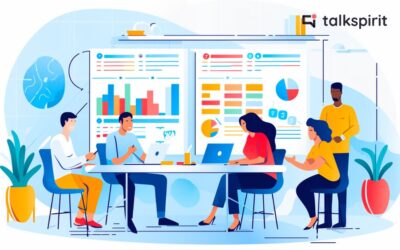Whether we call it an internal social network, collaborative social network or collaborative platform, this new tool might seem reserved for startups or other web and high-tech companies. Scratch that cliché! As an instrument of digital transformation, The ESN is useful to any type of organization: whether it is a SME, a large group, an association or whether it has a public service mission.
Need to convince yourself? Here is the example of the CPAM – the French Primary Health Insurance Fund – in Bas-Rhin, France, which has been using Talkspirit for three years for its 985 employees: combined feedback gathered by four of them.
Reducing a Primary Health Insurance Fund to a role of processing medical sheets? Mistake. Its mission is to protect everyone against illnesses, guarantee access to care, act for prevention, ensure the proper use of the health system… The missions are varied, and so are the professions; the CPAM in Bas-Rhin has 985 employees, spread over four sites, and several reception centers for the public. As in any company, internal communication is a necessity: Intranet, emails, internal magazine… Traditional solutions have shown their limits. “The largely decentralized structure [Editor’s note: the organization is spread over 4 geographical sites] forced us to think about communication a little differently,” says Sylvie Mansion, Managing Director. Thinking differently about communication was the beginning of the path that led the CPAM in Bas-Rhin to the enterprise social network.
A context which required to rethink internal communication and collaboration tools
Back then, information essentially went top-down, following the thread of the hierarchy. The pattern was simple: “Someone is talking, we don’t know exactly who it is, and it goes down,” explains Cédric Jean, communications manager. Moreover, information was disembodied, losing part of its ability to be interesting, and therefore to be absorbed. Hence the conclusion that it was useless… Besides this pyramidal organization, CPAM was organized in “silos” that had difficulty communicating with each other. In addition, a significant part of the staff was working from home (because the organisation had changed its working methods)… The need for an ergonomic and specialized communication tool seemed obvious, and urgent!
Read also: Know everything about the digital workplace – Definition
The ESN gradually became the obvious solution
A reflection process initiated in 2016 brought to light several key notions: transversality, sharing, exchanges… And the ESN idea quickly imposed itself.
The talkspirit tool now gives everyone a voice, and spreads information with a variable structure (for the sake of relevance!), depending on the communities it concerns. Membership of a certain number of groups is up to each employee’s choice. With the ESN, information is no longer overwhelming: it is embodied, identifiable and personalized, since it is sorted and targeted. Personalization, a reach guarantee? No doubt about it.
The other advantage is saving time.
Collecting information, processing it and then redistributing it, “it was quite time-consuming and in the end there could be a loss of information. This is 360-degree communication… In a self-managing manner,” explains Aurélie Wipff, unit manager.
Read also: Corporate Social Network: THE good idea to improve your internal communication
CPAM began with a broad survey among employees to assess the digital maturity of each one. Many were private users of social networks (except for the CEO, according to her), which facilitated the deployment of the ESN in some cases and raised fears in others. The intuitive ergonomics of talkspirit allowed those who did not think they were capable of mastering the tool to easily adopt it, sometimes with guidance for the first steps.
400 of the nearly 1,000 employees were part of an initial experimental phase, then 300 others joined them, to soon reach the full workforce. It was not so much a technical challenge, but rather a challenge in terms of usage: we had to encourage people to participate, to post, to bring the collaboration platform to life. A cultural challenge, because not everyone is used to communicating, contributing, sharing. Management also did a lot of work to reassure and explain, to avoid suspicion and distrust: was Talkspirit a tool for monitoring, for evaluating the relevance of each person, the usefulness of each person? Trust came quickly with use. The creation of groups which were not focused on work, but rather on the life of the company, undoubtedly also helped. Everyone quickly saw the concrete usefulness of such a tool, regardless of their field.
Read also: Build community through communication
The advantages of a collaborative network
Everyone has interesting information to share within the sphere of their activity, observes Cédric Jean. Talkspirit facilitates circulation, and “promotes inter-knowledge of the services“: who are the people who work there, what exactly they do, their contacts and their actions (internally and also outside CPAM). This also means a better knowledge of the staff whom one does not necessarily have the opportunity to work with, and an awareness of others working in the organisation.
“Beyond the way we communicate and exchange information, beyond the interactivity, there is also a personal experience,” emphasizes the Executive Director. The network makes everyone proactive with information. And since they share it, everyone is more involved in what they are doing and what others are doing.
Collaborative platform. The risk of saturation?
The platform made it possible to work differently, with others. To begin with, it has allowed for a return to a “healthier” use of email internally. “My mailbox is much cleaner,” says Sarah Richard, communications officer. Talkspirit and its group-based organisation is certainly a way of sorting information so that it can be found quickly. The tool makes the (so often) endless email loops unnecessary.
90% of the CPAM’s employees log on daily. A success that could have its downside. It was feared that this could open the door to non-professional publications, but no drift has been observed on this side. “In the professional context, the social network is self-regulating, people don’t forget that they are at work”. said Sarah Richard.
The other possible drift is overabundance. Like the effect of grouped emails and “reply to all” that we could do without. However, talkspirit eliminates this danger through group determination. Everyone is a member of a group because he or she is linked to its activity, because he or she is interested in the group’s subject, or because it is a group linked to a project to which he or she contributes. Information is no longer a pile of data whose volume makes it impossible to see clearly what is important. It is a choice. This undoubtedly also helps everyone to avoid posting compulsively. We are aware that at the other end of the post, someone will spend some time reading it.
Social networking and personalized usage
Sarah, communication manager, particularly appreciates the functionality allowing her to survey employees: polls. She uses them to test a visual, the title of an article she is considering, or to collect contributions that will feed the internal magazine.
Sylvie Mansion, Managing Director, has used Talkspirit for political purposes. In the right way, of course! During a negotiation regarding working-time adjustments (a highly sensitive subject!), she systematically communicated the progress of the negotiations. The posts were read by all staff, on a daily basis, for about ten days. This made it possible to neutralize hallway rumors and false information, which are counterproductive for everyone. The ESN is also a tool for pacification and transparency.
Finally, Aurélie Wipff, unit manager, found the collaboration platform to be the ideal way to keep in touch with her team, half of whom are working remotely. “In particular, I use talkspirit to manage my projects, issue alerts or give good practices to my employees,” she says.
Read also: How the Bergamote Agency reduced its emails by 95% and boosted its productivity with Talkspirit
The evidence of effectiveness in terms of internal communication and collaboration, particularly remotely, is evident. The additional virtuous effect of an enterprise social network is that this transversality brings involvement and commitment. Cédric Jean does not want to use the term “participatory democracy”, but it is in any case about participative and collaborative DNA. Everyone can express themselves, and if everyone does not do so on a daily basis, access to information is guaranteed for everyone: one can comment, “like”, “like”… A referendum and a permanent thermometer.
The choice of belonging to this or that group on the collaborative platform is also a guarantee of democracy. The choice of the information that is relevant to us, that interests us, and the freedom not to avoid being burdened with information that does not concern us.
Finally, Talkspirit, due to the horizontality of the collaborative network, was also an opportunity to change the prism of management’s vision. An open window on a new governance?
The adventure has only just begun!
*
* *
Are you a communication/advertising/marketing agency wanting to know more about talkspirit? Contact us or ask to schedule a personalized demo.
–
Benoit Renoul Chief Marketing Officer, Talkspirit



